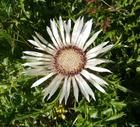 Also called dwarf thistle and silver thistle, this short-lived herbaceous perennial is a native of alpine regions of central and southern Europe where it grows in poor soil in dry sandy pastures and rocky slopes, especially on limestone. It is a member of the aster family, Asteraceae, that also includes daisy, yarrow, and lettuce. Plants grow from a tap root and form a rosette of spiny, pinnately lobed leaves 6″ high and 12″ across. Over time, the number of rosettes increase to form a large plant up to 3′ across. In late summer to early fall each rosette produces a 4″ wide papery flowerhead that is almost stalkless and composed of silvery-white ray flowers around a center of yellow-brown tubular disc flowers. The flowerhead closes up in wet weather. In addition, the flowerhead can be eaten like an artichoke. Stemless carline thistle is a good choice for a rock garden, alpine garden or wall planting. The genus name, Carlina, honors Charlemagne ( Carolus Magnus in Latin) because he is said to have been offered the plant by an angel to cure the bubonic plague that was devastating his troops. The specific epithet, acaulis, is the Greek prefix a, meaning the not, and the Latin word caulis, meaning stalk of a plant, and refers to the almost stalkless flower.
Also called dwarf thistle and silver thistle, this short-lived herbaceous perennial is a native of alpine regions of central and southern Europe where it grows in poor soil in dry sandy pastures and rocky slopes, especially on limestone. It is a member of the aster family, Asteraceae, that also includes daisy, yarrow, and lettuce. Plants grow from a tap root and form a rosette of spiny, pinnately lobed leaves 6″ high and 12″ across. Over time, the number of rosettes increase to form a large plant up to 3′ across. In late summer to early fall each rosette produces a 4″ wide papery flowerhead that is almost stalkless and composed of silvery-white ray flowers around a center of yellow-brown tubular disc flowers. The flowerhead closes up in wet weather. In addition, the flowerhead can be eaten like an artichoke. Stemless carline thistle is a good choice for a rock garden, alpine garden or wall planting. The genus name, Carlina, honors Charlemagne ( Carolus Magnus in Latin) because he is said to have been offered the plant by an angel to cure the bubonic plague that was devastating his troops. The specific epithet, acaulis, is the Greek prefix a, meaning the not, and the Latin word caulis, meaning stalk of a plant, and refers to the almost stalkless flower.
Type: Short-lived herbaceous perennial
Bloom: Flowerhead 4″ across with silvery-white ray flowers around yellow brown tubular disc flowers in late summer to early fall
Size: 6″ H x 12″ W
Light: Full. sun; tolerates shade but may not bloom well.
Soil: Lean, moderately moist, very well-drained, alkaline; drought tolerant when established
Hardiness: Zones 4-8
Care: Low maintenance
Pests and Diseases: Rot if in poorly drained soil
Propagation: Seed; does not transplant well.
Companion Plants: Creeping sedums, blue fescue, artemesia
Photo Credit: Wikipedia